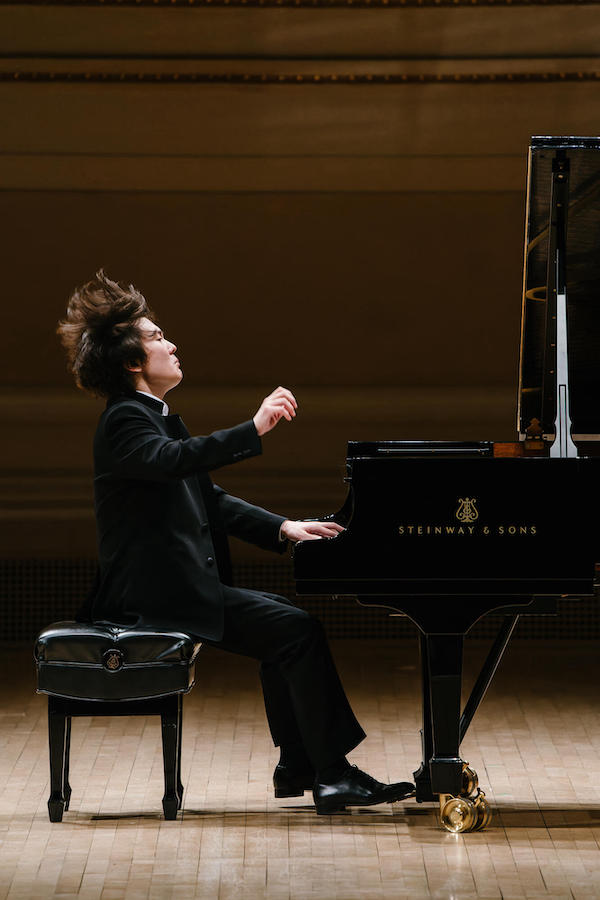Pianist Cho gives operatic voice to variations at Carnegie
Seong-Jin Cho’s recital at Carnegie Hall Wednesday night stood out for a rare kind of pearly, luxurious piano tone. Until it didn’t.
The Seoul-born, Berlin-based pianist set the expressive poles for a night of Brahms and Schumann with brief works by Handel and Sofia Gubaidulina, bubbling through the former’s Suite No. 5 in E major (“Harmonious Blacksmith”), then attacking the Russian composer’s granitic Chaconne.
His distinctive tone, which seemed at times almost to glow from within, showed up immediately in the improvisatory Prelude to Handel’s suite. The ensuing Allemande and Courante flowed freely too, with a touch of Romantic gloss, which he achieved without ever touching the damper pedal. In the closing variations, the blacksmith’s hammer was made of felt, and the “doubles” (variations) arrived on the double, in ever-speedier display.
The transition from fleet, elusive Handel to the craggy theme of Gubaidulina’s dissonant showpiece was a wake-up call. The variations tumbled out in quick succession, calling for everything from tender caresses to athletic leaps and from Debussy-style watery chimes to a Lisztian roar of left-hand octaves. Here and elsewhere in the program, Cho reveled in the enormous fortissimos he could draw from the big Steinway without ever banging.
Where did Brahms’s Variations and Fugue on a Theme of Handel figure in what was clearly a thought-out program? At the center of the evening, Op. 24 seemed to be at the midpoint of other dimensions as well: classical vs. Romantic, restrained vs. showy, intellectual vs. visceral.
Preceding Brahms’s piece on this program with Handel’s own “Handel Variations” was an inspired idea, a little blunted in the execution by a limitation in Cho’s palette of touches: the lack of clear, fingertip articulation and its cousin, a true leggiero. The pianist’s seductive tone tended to wrap everything in a pearly mist, from Handel’s dance movements to the stately tune Brahms chose for his variations. Some of the wittier Brahms flourishes, such as the con vivacità Vars. VII and VIII and the music-box Var. XXII, could have used more lightness and zing, and at times rushing the tempo took the place of liveliness in the tone.
But in general Cho projected beautifully his concept of the Brahms work as a cycle of Romantic character pieces à la Schumann, giving each variation its own mood and weight while moving the piece forward. In the melodious variations, his top tone glowed while inner voices had their subtle say. The doleful sixths of the slow-marching Var. XIII and the soulful left-hand octaves of Var. XX resonated deeply. The dashing Vars. IV and XIV and the gathering storm of Vars. XXIII-XXV were as brilliant and energetic as one could wish.
On this night the closing Fugue, modeled on Bach’s massive organ fugues, could have used more Baroque-style clarity of counterpoint, but one had to admire the pianist’s tonal shifts in the episodes, imitating organ registration with only fingers on keys, and his ability to flex the tempo expressively without sapping the movement’s inexorable momentum.
Cho opened the recital’s second half with a group of character pieces from Brahms’s later Op. 76, by way of a prelude to the remaining large work, Schumann’s Symphonic Etudes, Op. 13. (In fact, he proceeded directly from Brahms to Schumann without stopping for applause.)
A chilly breeze of 16th notes blew through the Capriccio in F-sharp minor, Op. 76, no. 1, as tender melodies wavered between light and shadow. One missed the leggiero touch in the jaunty no. 2, Capriccio in B minor, but the middle section sang prettily. Elusive harmonically, no. 4, Intermezzo in B-flat major, softly showcased Cho’s cantabile tone at its pearliest. The stormy no. 5, Capriccio in C-sharp minor, roared under its pleading themes, with sudden drops to pianissimo, before a resolute charge to the end.
Somehow holding that moment without applause, the pianist began the rather somber theme of Schumann’s Symphonic Etudes, wringing pathos from its moments of sudden forte. The composer went back and forth on the title of this piece, since his “etudes” are in fact variations, the first of which turned the theme into a tiny grotesque that became unexpectedly grand in the middle. With Cho’s booming bass and buildup of repeated chords, the second variation filled Carnegie with sound that Schumann would surely have found “symphonic.”
Again Cho proved to be the master of moods, edgy and marcato one moment and drawing out a tender soprano-tenor duet the next, and laughing at the composer’s extravagant technical demands throughout.
Five deleted variations were published after the composer’s death, and pianists differ on which, if any, to insert in their performance. Cho played the fourth of these, a tender Allegretto, after the Agitato Etude VI, and the fifth, a dreamy tinkle of interlocking lines, after the fist-shaking Etude VIII.
These variations, like Brahms’, concluded with a big finale—not a fugue this time, but a bounding, energetic movement in the grand symphonic manner à la Beethoven’s Fifth. Bent on making his 1837 piano sound like an orchestra, Schumann went as high and low as he could go, and pianist Cho was only too happy to cooperate on his late-model Steinway D. Pacing himself (barely), the master of fortissimo saved his mightiest crescendo for the end, to the audience’s delight.
His single encore brought this well-crafted program full circle to Handel, with a soft and hypnotic rendering of that composer’s Minuet in G minor, HWV 434, No. 4, arranged by Wilhelm Kempff.
Pianist Beatrice Rana performs works by Bach, Debussy and Beethoven 8 p.m. April 20 at Carnegie Hall. carnegiehall.org.



